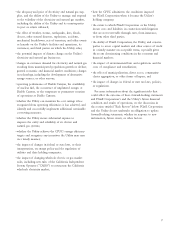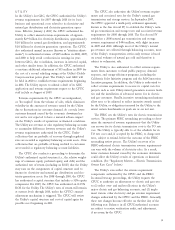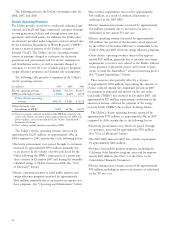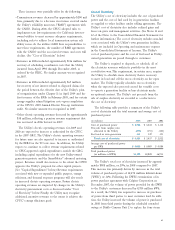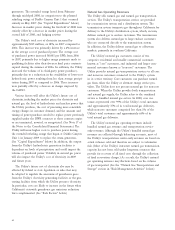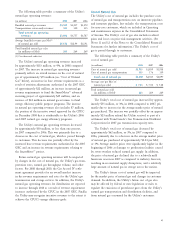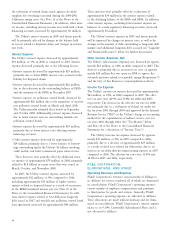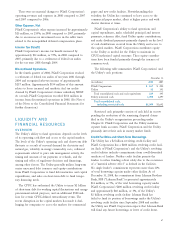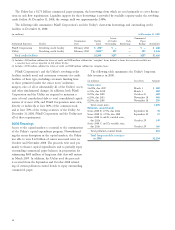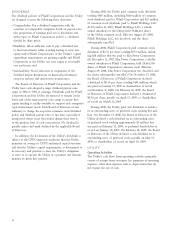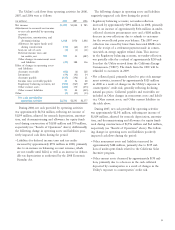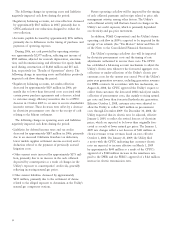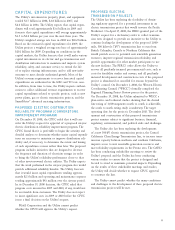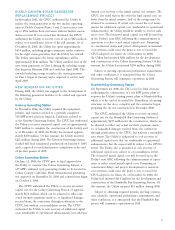PG&E 2008 Annual Report Download - page 49
Download and view the complete annual report
Please find page 49 of the 2008 PG&E annual report below. You can navigate through the pages in the report by either clicking on the pages listed below, or by using the keyword search tool below to find specific information within the annual report.
47
paper and new credit facilities. Notwithstanding this
volatility, the Utility has continued to have access to the
commercial paper market, albeit at higher prices and with
shorter duration at times.
PG&E Corporation’s ability to fund operations and
capital expenditures, make scheduled principal and interest
payments, refi nance debt, fund Utility equity contributions,
and make dividend payments primarily depends on the level
of cash distributions received from the Utility and access to
the capital markets. PG&E Corporation contributes equity
to the Utility as needed for the Utility to maintain its
CPUC-authorized capital structure. These equity contribu-
tions have been funded primarily through the issuance of
common stock.
The following table summarizes PG&E Corporation’s and
the Utility’s cash positions:
December 31,
(in millions) 2008 2007
PG&E Corporation $ 167 $ 204
Utility 52 141
Total consolidated cash and cash equivalents 219 345
Utility restricted cash 1,290 1,297
Total consolidated cash,
including
restricted
cash $1,509 $1,642
Restricted cash primarily consists of cash held in escrow
pending the resolution of the remaining disputed claims
fi led in the Utility’s reorganization proceeding under
Chapter 11. PG&E Corporation and the Utility maintain
separate bank accounts. PG&E Corporation and the Utility
primarily invest their cash in money market funds.
Credit Facilities and Short-Term Borrowings
The Utility has a $2 billion revolving credit facility and
PG&E Corporation has a $200 million revolving credit facil-
ity. Each of PG&E Corporation’s and the Utility’s revolving
credit facilities includes commitments from a well-diversifi ed
syndicate of lenders. Neither credit facility permits the
lenders to refuse funding a draw solely due to the occurrence
of a “material adverse effect” as defi ned in the facilities.
No single lender’s commitment represents more than 11%
of total borrowing capacity under either facility. As of
December 31, 2008, the commitment from Lehman Brothers
Bank, FSB (“Lehman Bank”) represented approximately
$13 million, or 7%, of the total borrowing capacity under
PG&E Corporation’s $200 million revolving credit facility
and approximately $60 million, or 3%, of the Utility’s
$2 billion revolving credit facility. Lehman Bank has
failed to fund its portion of borrowings under the Utility’s
revolving credit facility since September 2008 and neither
the Utility nor PG&E Corporation expects that Lehman Bank
will fund any future borrowings or letter of credit draws.
There were no material changes to PG&E Corporation’s
operating revenues and expenses in 2008 compared to 2007
and 2007 compared to 2006.
Other Expense, Net
PG&E Corporation’s other expense increased by approximately
$23 million, or 255%, in 2008 compared to 2007, primarily
due to an increase in investment losses in the rabbi trusts
related to the non-qualifi ed deferred compensation plans.
Income Tax Benefi t
PG&E Corporation’s income tax benefi t increased by
approximately $31 million, or 97%, in 2008 compared to
2007, primarily due to a settlement of federal tax audits
for the tax years 2001 through 2004.
Discontinued Operations
In the fourth quarter of 2008, PG&E Corporation reached
a settlement of federal tax audits of tax years 2001 through
2004 and recognized after-tax income of approximately
$257 million. Approximately $154 million of this amount
relates to losses incurred and synthetic fuel tax credits
claimed by PG&E Corporation’s former subsidiary NEGT.
As a result, PG&E Corporation recorded $154 million in
income from discontinued operations in 2008. (See Note 6
of the Notes to the Consolidated Financial Statements for
further discussion.)
LIQUIDITY AND
FINANCIAL RESOURCES
OVERVIEW
The Utility’s ability to fund operations depends on the levels
of its operating cash fl ow and access to the capital markets.
The levels of the Utility’s operating cash and short-term debt
fl
uctuate as a result of seasonal demand for electricity and
natural gas, volatility in energy commodity costs, collateral
requirements related to price risk management activity, the
timing and amount of tax payments or refunds, and the
timing and effect of regulatory decisions and fi nancings,
among other factors. The Utility generally utilizes long-term
senior unsecured debt issuances and equity contributions
from PG&E Corporation to fund debt maturities and capital
expenditures, and relies on short-term debt to fund tempo-
rary fi nancing needs.
The CPUC has authorized the Utility to incur $2 billion
of short-term debt for working capital fl uctuations and energy
procurement-related purposes, and an additional $500 mil-
lion for certain CPUC-defi ned extraordinary events. The
recent disruption in the capital markets has made it chal-
lenging for companies to access the markets for commercial


